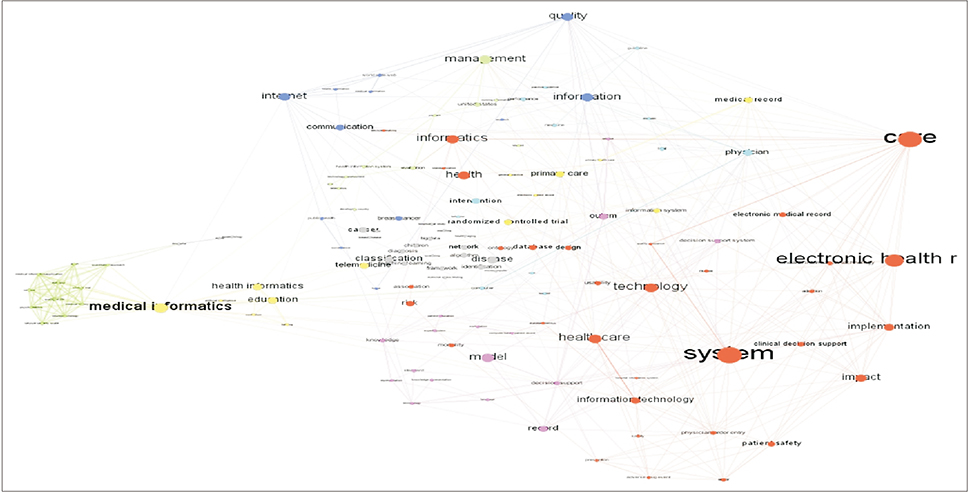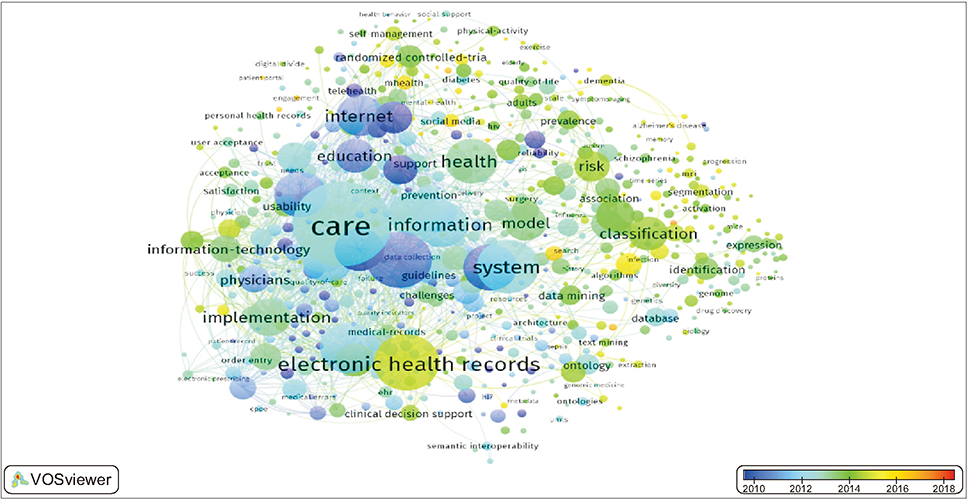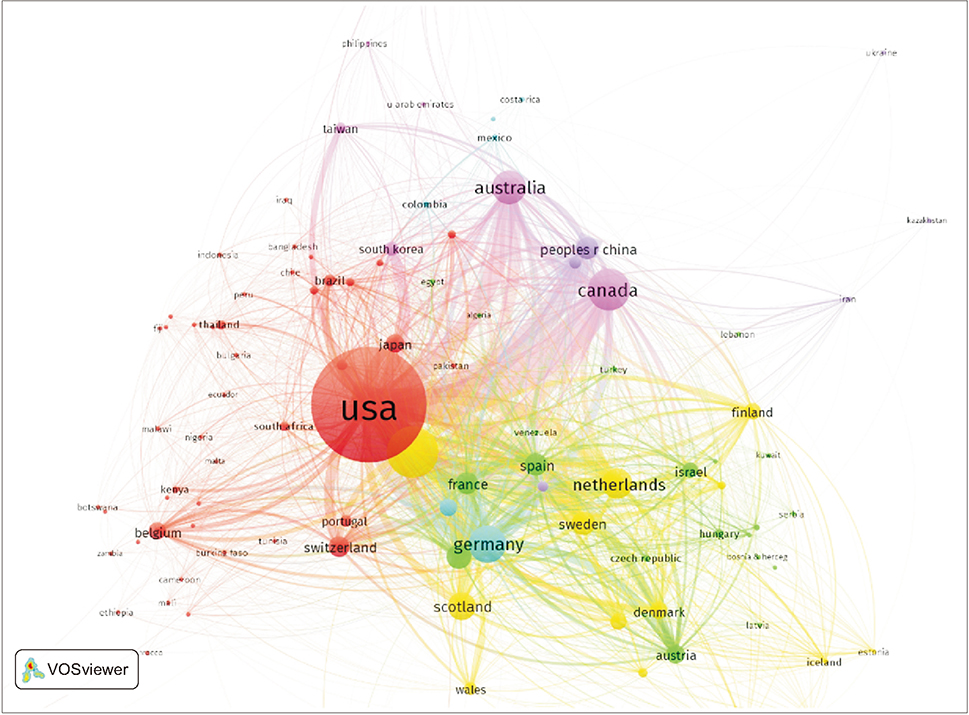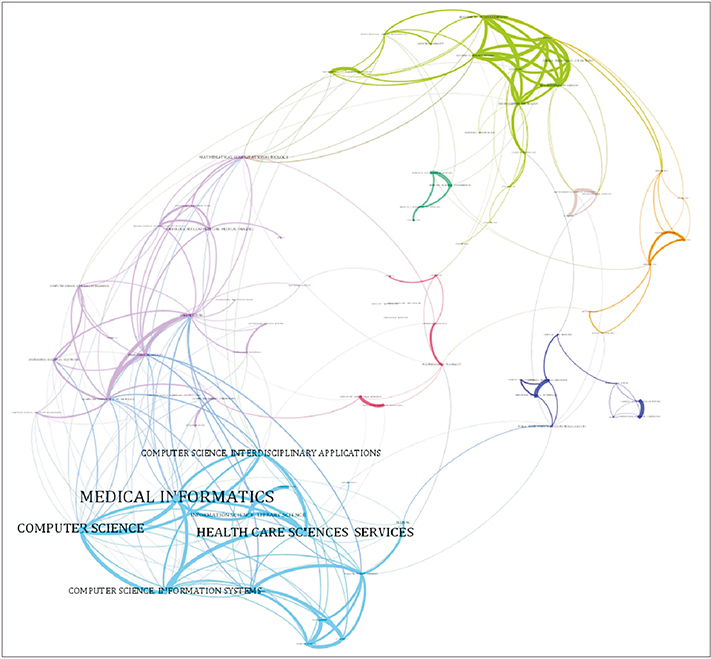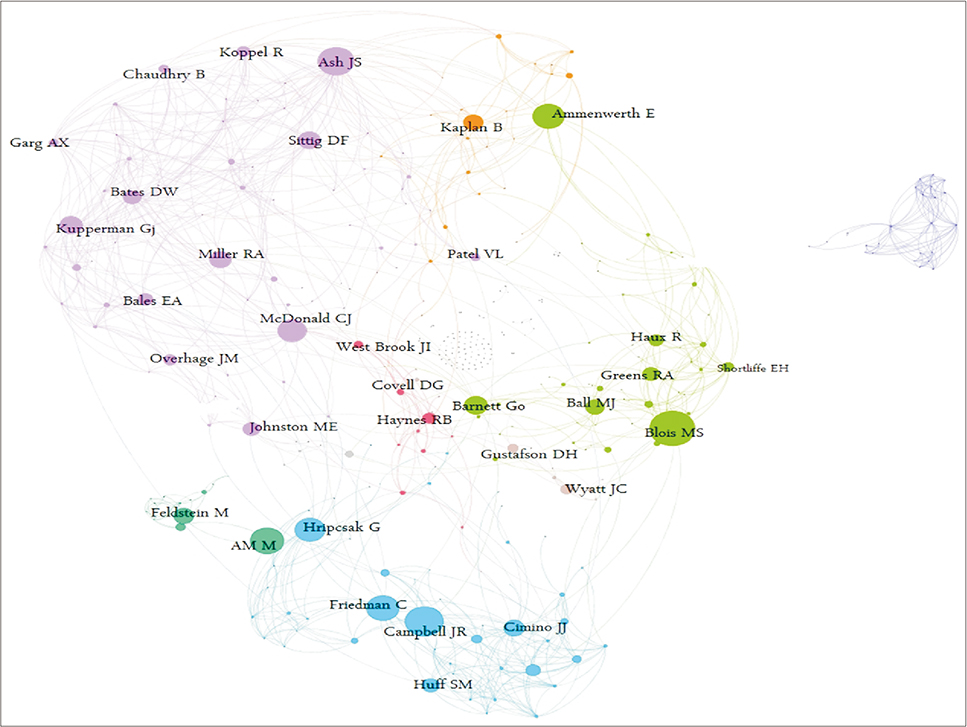Healthc Inform Res.
2019 Apr;25(2):61-72. 10.4258/hir.2019.25.2.61.
Analyzing and Visualizing Knowledge Structures of Health Informatics from 1974 to 2018: A Bibliometric and Social Network Analysis
- Affiliations
-
- 1Management Studies Center, Tarbiat Modares University, Tehran, Iran. t.saheb@modares.ac.ir
- 2Caspian Higher Education Institute, Qazvin, Iran.
- KMID: 2445002
- DOI: http://doi.org/10.4258/hir.2019.25.2.61
Abstract
OBJECTIVES
This paper aims to provide a theoretical clarification of the health informatics field by conducting a quantitative review analysis of the health informatics literature. And this paper aims to map scientific networks; to uncover the explicit and hidden patterns, knowledge structures, and sub-structures in scientific networks; to track the flow and burst of scientific topics; and to discover what effects they have on the scientific growth of health informatics.
METHODS
This study was a quantitative literature review of the health informatics field, employing text mining and bibliometric research methods. This paper reviews 30,115 articles with health informatics as their topic, which are indexed in the Web of Science Core Collection Database from 1974 to 2018. This study analyzed and mapped four networks: author co-citation network, co-occurring author keywords and keywords plus, co-occurring subject categories, and country co-citation network. We used CiteSpace 5.3 and VOSviewer to analyze data, and we used Gephi 0.9.2 and VOSviewer to visualize the networks.
RESULTS
This study found that the three major themes of the literature from 1974 to 2018 were the utilization of computer science in healthcare, the impact of health informatics on patient safety and the quality of healthcare, and decision support systems. The study found that, since 2016, health informatics has entered a new era to provide predictive, preventative, personalized, and participatory healthcare systems.
CONCLUSIONS
This study found that the future strands of research may be patient-generated health data, deep learning algorithms, quantified self and self-tracking tools, and Internet of Things based decision support systems.
MeSH Terms
Figure
Cited by 1 articles
-
Keyword Trends for Mother–Child Oral Health in Korea Based on Social Media Big Data from Naver
Jung-Eun Park, Ja-Won Cho, Jong-Hwa Jang
Healthc Inform Res. 2020;26(3):212-219. doi: 10.4258/hir.2020.26.3.212.
Reference
-
1. Carter CE, Veale BL. Digital radiography and PACS. St. Louis (MO): Mosby;2008.2. Fitzgerald-Hayes M, Reichsman F. DNA and biotechnology. Boston (MA): Elsevier;2010.3. Smallwood RF. Managing electronic records: Methods, best practices, and technologies. Hoboken (NJ): John Wiley & Sons;2013.4. Ballweg R, Brown D, Vetrosky DT, Ritsema TS. Physician assistant: a guide to clinical practice. Philadelphia (PA): Elsevier;2017.5. O'Carroll PW, Ripp LH, Yasnoff WA, Ward ME, Martin EL. Public health informatics and information systems. New York (NY): Springer;2003.6. Masic I. The history and new trends of medical informatics. Donald School J Ultrasound Obstet Gynecol. 2013; 7(3):301–302.
Article7. Bronzino JD. Medical devices and systems. Boca Raton (FL): CRC Press;2006.8. Scaletti A. Evaluating investments in health care systems: health technology assessment. Heidelberg: Springer;2014.9. Hayes BM, Aspray W. Health informatics: a patient-centered approach to diabetes. Cambridge (MA): MIT Press;2010.10. Deng H, Wang J, Liu X, Liu B, Lei J. Evaluating the outcomes of medical informatics development as a discipline in China: a publication perspective. Comput Methods Programs Biomed. 2018; 164:75–85.
Article11. Kruse CS, Stein A, Thomas H, Kaur H. The use of electronic health records to support population health: a systematic review of the literature. J Med Syst. 2018; 42(11):214.
Article12. Ross T. A survival guide for health research methods. Maidenhead, UK: McGraw-Hill Education;2012.13. Walker E, Hernandez AV, Kattan MW. Meta-analysis: its strengths and limitations. Cleve Clin J Med. 2008; 75(6):431–439.
Article14. Stegenga J. Is meta-analysis the platinum standard of evidence? Stud Hist Philos Biol Biomed Sci. 2011; 42(4):497–507.
Article15. Watanabe M. Going multidisciplinary. Nature. 2003; 425(6957):542–543.
Article16. Chen C. Mapping scientific frontiers: the quest for knowledge visualization. London: Springer;2013.17. Xu G, Zhang Y, Li L. Web mining and social networking: techniques and applications. New York (NY): Springer;2011.18. Gonzalez GH, Tahsin T, Goodale BC, Greene AC, Greene CS. Recent advances and emerging applications in text and data mining for biomedical discovery. Brief Bioinform. 2016; 17(1):33–42.
Article19. Aggarwal CC, Wang H. Text mining in social networks. In : Aggarwal CC, editor. Social network data analytics. Boston (MA): Springer;2011. p. 353–378.20. Bornmann L, Haunschild R, Hug SE. Visualizing the context of citations referencing papers published by Eugene Garfield: a new type of keyword co-occurrence analysis. Scientometrics. 2018; 114(2):427–437.
Article21. Khokhar D. Gephi cookbook. Birmingham, UK: Packt Publishing Ltd.;2015.22. Parente ST, McCullough JS. Health information technology and patient safety: evidence from panel data. Health Aff (Millwood). 2009; 28(2):357–360.
Article23. Alotaibi YK, Federico F. The impact of health information technology on patient safety. Saudi Med J. 2017; 38(12):1173–1180.
Article24. Kaelber DC, Bates DW. Health information exchange and patient safety. J Biomed Inform. 2007; 40:6 Suppl. S40–S45.
Article25. Kawamoto K, Houlihan CA, Balas EA, Lobach DF. Improving clinical practice using clinical decision support systems: a systematic review of trials to identify features critical to success. BMJ. 2005; 330(7494):765.
Article26. Sim I, Gorman P, Greenes RA, Haynes RB, Kaplan B, Lehmann H, et al. Clinical decision support systems for the practice of evidence-based medicine. J Am Med Inform Assoc. 2001; 8(6):527–534.
Article27. Bates DW, Cohen M, Leape LL, Overhage JM, Shabot MM, Sheridan T. Reducing the frequency of errors in medicine using information technology. J Am Med Inform Assoc. 2001; 8(4):299–308.
Article28. Bauchner H, Simpson L, Chessare J. Changing physician behaviour. Arch Dis Child. 2001; 84(6):459–462.
Article29. Shiffman RN, Liaw Y, Brandt CA, Corb GJ. Computer-based guideline implementation systems: a systematic review of functionality and effectiveness. J Am Med Inform Assoc. 1999; 6(2):104–114.
Article30. Purcell GP, Wilson P, Delamothe T. The quality of health information on the internet. BMJ. 2002; 324(7337):557–558.
Article31. Gagliardi A, Jadad AR. Examination of instruments used to rate quality of health information on the internet: chronicle of a voyage with an unclear destination. BMJ. 2002; 324(7337):569–573.
Article32. Skiba DJ. Informatics competencies for nurses revisited. Nurs Educ Perspect. 2016; 37(6):365–367.
Article33. Graves JR, Corcoran S. The study of nursing informatics. Image J Nurs Sch. 1989; 21(4):227–231.
Article34. Bickley L, Szilagyi PG. Bates' guide to physical examination and history-taking. Philadelphia (PA): Lippincott Williams & Wilkins;2012.35. Hersh W. Medical informatics education: an alternative pathway for training informationists. J Med Libr Assoc. 2002; 90(1):76–79.36. Norris AC. Current trends and challenges in health informatics. Health Informatics J. 2002; 8(4):205–213.
Article37. Gagnon MP, Ngangue P, Payne-Gagnon J, Desmartis M. m-Health adoption by healthcare professionals: a systematic review. J Am Med Inform Assoc. 2016; 23(1):212–220.
Article38. Wilkowska W, Ziefle M. Privacy and data security in ehealth: requirements from the user's perspective. Health Informatics J. 2012; 18(3):191–201.
Article39. Pilemalm S, Timpka T. Third generation participatory design in health informatics: making user participation applicable to large-scale information system projects. J Biomed Inform. 2008; 41(2):327–339.
Article40. Kvedar J, Coye MJ, Everett W. Connected health: a review of technologies and strategies to improve patient care with telemedicine and telehealth. Health Aff (Millwood). 2014; 33(2):194–199.
Article41. Swan M. Health 2050: the realization of personalized medicine through crowdsourcing, the quantified self, and the participatory biocitizen. J Pers Med. 2012; 2(3):93–118.
Article
- Full Text Links
- Actions
-
Cited
- CITED
-
- Close
- Share
- Similar articles
-
- Knowledge Structure of Korean Medical Informatics: A Social Network Analysis of Articles in Journal and Proceedings
- Journal metrics, document network, and conceptual and social structures of the Korean Journal of Anesthesiology from 2017 to July 2022: a bibliometric study
- Application of Social Network Analysis to Health Care Sectors
- A Study on the Knowledge Structure of Cancer Survivors based on Social Network Analysis
- A Text Mining Analysis of HPV Vaccination Research Trends

